Planting potatoes is a bit more complicated than it is for other veggies, and it’s even more important do it right. So in this post, I’m going to show you exactly when and how to plant them step by step.
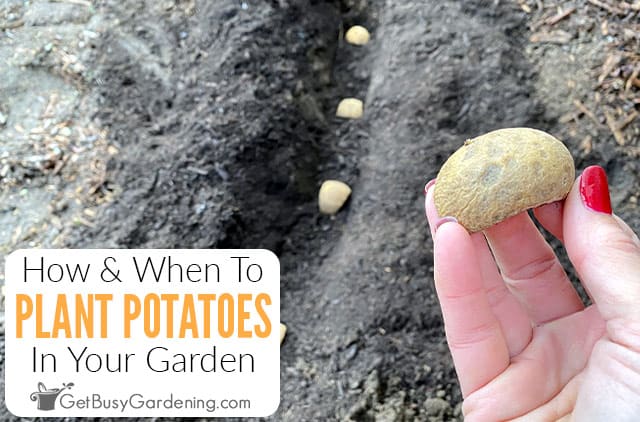
If you’re hoping to grow potatoes in your garden, learning the best timing and techniques for planting them is essential.
In order to get the biggest and best yield, it’s important to not only plant potatoes the right way and at the right time, but to properly prepare them beforehand too.
With this guide on when and how to plant potatoes, you’ll learn everything you need to know to get them started off right.
What’s The Best Way To Plant Potatoes?
Unlike many vegetables, they are rarely grown from seed because it takes way too long for them to mature and start producing.
Instead, the best and most reliable way to plant potatoes is by purchasing a special type of tuber called a ‘seed potato’, which is specifically cultivated for crop production.
Given enough space, fertile soil, and plenty of sunshine, a single seed potato can produce plenty of food in your home garden.
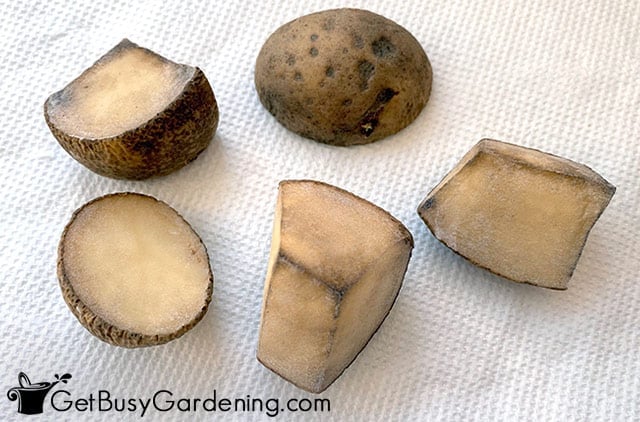
Where To Plant Potatoes
The best location for planting potatoes is in a full sun bed that has loose, well-draining soil. Ideally, they prefer a slightly acidic medium, with a pH of 5-6.5.
Raised beds, large containers, or a veggie plot are all great options. Some garden centers may even sell bags or kits designed specifically for your spuds.
When To Plant Potatoes
Most gardeners plant their potatoes in early spring once the ground temperature reaches 45°F or warmer. You can use a soil thermometer to monitor it.
In cold climates, this will be about 3-4 weeks before your last frost date. But in warmer areas it may be earlier.
It’s especially important to plant them as soon as you can if you live in a warm climate. That way they’ll be ready well before the hot summer weather kicks in.
Related Post: How To Can Potatoes
How To Prepare Potatoes For Planting
Before planting, you’ll need to prepare your seed potatoes. Any that are the size of a golf ball or smaller can be used whole. But if they are larger, you should cut them into smaller sections first.
Leaving bigger ones whole generally results in a large, multi-stemmed plant that will use too much energy on foliage production – meaning less potatoes for you.
Cut the large tubers into 2” chunks, making sure there are at least two eyes per piece. The eyes, or buds, are the small indentations or marks that new stems sprout from.
Let the pieces sit out to cure at room temperature for 1-2 days until they form a callous over the cuts. That will help prevent them from rotting.
Related Post: Easy Healthy Potato Soup Recipe
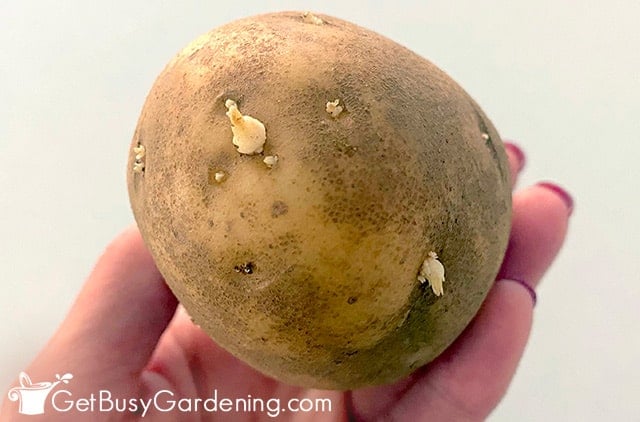
Chitting Potatoes
While chitting potatoes is an optional step, it’s something many seasoned gardeners like to do before planting.
Don’t be put-off by this fancy term, it’s simply a different word for sprouting. You can think of it as giving them a head start.
To chit your potatoes, keep them in indirect light in a room that’s about 70°F. Allow the eyes to sprout, just like they do when left in your pantry for too long.
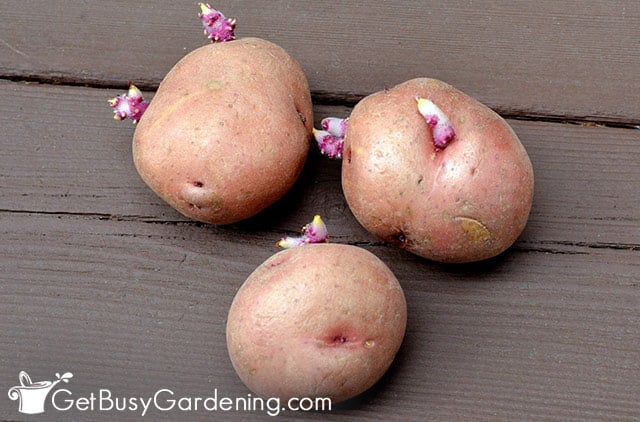
Potato Spacing Requirements
It’s very important to provide enough spacing while planting your potatoes so they won’t compete for food or water. Positioning them too close together can cause smaller potatoes.
Placing them in rows is most common. Keep 3’ between each row, and space each piece within the row 12” apart.
How Deep To Plant Potatoes
In order for plenty of tubers to form, it’s important to plant your potatoes at the proper depth.
Each row should consist of a trench that’s 6-8” deep, narrowing towards the bottom to provide a base to nestle the pieces into.
Hilling Potatoes
Several weeks after planting, as your potatoes get taller, you should continue to build the soil up around them.
The edible tubers form along the stem. When potatoes are exposed to sunlight, they’ll produce a toxin called solanine that turns them green.
To avoid that, and encourage larger yields, you’ll need to keep them buried.
For every 8” of growth, or when you see new tubers forming, cover half the stem with soil by building a mound around it. Continue to hill your potatoes until they begin to flower.
Related Post: When & How To Harvest Potatoes
FAQs About Planting Potatoes
Here I’ve answered some of the most frequently asked questions about planting potatoes. If yours isn’t here, add it to the comments section below.
What month do you plant potatoes?
The month you plant potatoes depends on your climate. Find the last expected frost date for your region, and start checking on the soil temperature 4-5 weeks before then. When the soil is workable and warm enough, it’s time.
Can you plant a potato from the grocery store?
Yes, you can technically plant a potato from the grocery store, but it’s best to buy organic if you want to try it. Non-organic ones are treated with a chemical that prevents the eyes from sprouting.
Keep in mind that even organic ones may not be disease resistant like seed potatoes are. So using grocery store potatoes may end up introducing diseases into your garden.
Can you plant a whole potato?
You can plant a whole potato if it’s the size of a golf ball or smaller. Larger ones will result in massive plants that struggle to produce good sized tubers. So cut larger ones up into several pieces first for the best results.
How deep do you plant potatoes?
The proper depth for planting potatoes is between 6-8” to allow plenty of room for tuber formation and hilling.
With these tips, even beginner gardeners can plant potatoes successfully. Follow the step by step instructions to get yours started off on the right foot.
More About Vegetable Gardening
- When & How To Plant Garlic In Your Garden
- Growing Vegetables: The Ultimate Veggie Garden Guide
- Guide To The Best Fertilizers For Vegetable Gardens
- How & When To Plant Ginger Root
Share your tips for when and how to plant potatoes in the comments section below.
How To Plant Potatoes
How To Plant Potatoes Step-By-Step

When you’re ready to plant potatoes, follow these easy step by step instructions to get them settled into your garden happily.
Materials
- Seed potatoes
- Compost
- Slow release fertilizer
- Water
Tools
- Shovel or trowel
- Garden gloves
- Large container (optional)
Instructions
- Choose a location - Pick a sunny spot in your garden that has well-draining soil, or use a large pot with drainage holes.
- Prepare the soil - Amend the soil with compost and slow release fertilizer, and remove any weeds or large rocks.
- Dig a trench - Start by digging your rows, each up to 8” deep and 3’ apart. Keep the displaced soil nearby to cover the stems as they get taller in the following weeks.

- Plant potato pieces - Each piece should be positioned so the eyes (or sprouts for chitted potatoes) are facing up. Be sure to allow for 12” of space between them.

- Cover with soil - Gently bury the pieces with about 3" of soil so they are completely covered, but the top of the trench is still open.
- Water until moist - Moisten the soil enough to wet it, but not to the point where it’s soggy or puddling.
Notes
- Always make sure your seed potatoes are well-cured before planting them.

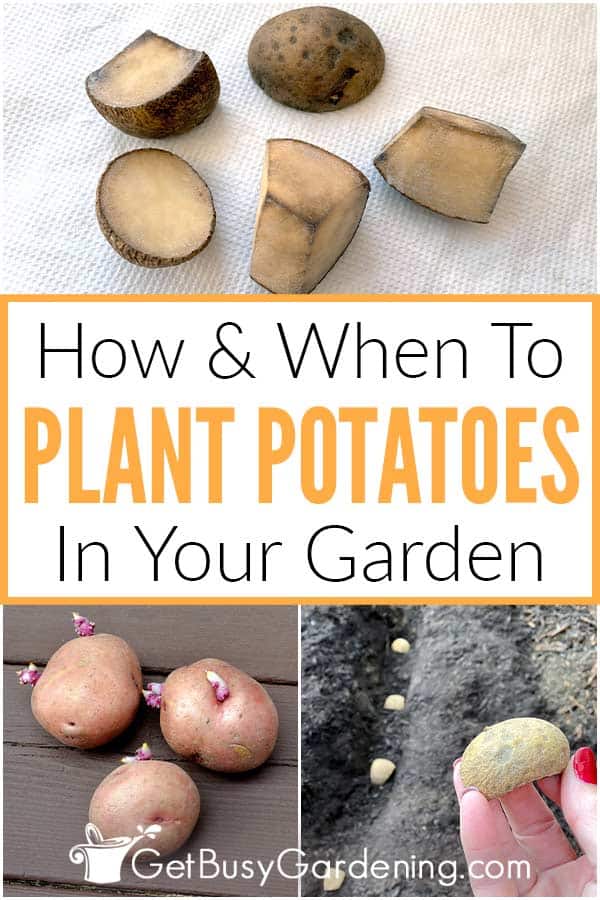


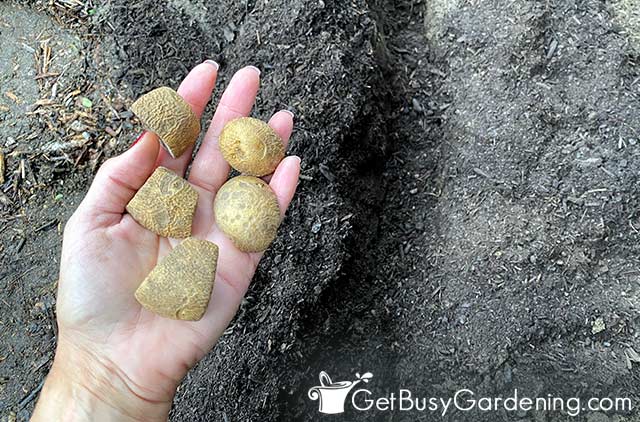


Jim says
How do I know when my potatoes are ready to dig up?
Amy Andrychowicz says
You’ll know your potatoes are ready to harvest once the plant dies back completely. Here’s my full guide for when and how to harvest your potatoes for more details.
Malissa Brock says
This is my first time growing potatoes. I have a garden every year but never grew potatoes. Is there any tips u need to know about potatoes
Amy Andrychowicz says
Here’s my full guide for how to grow potatoes.
Colleen Cartier says
Great article, thank you!
I was wondering if you know if washing the potatoes would remove the chemical that keeps potatoes from sprouting Thank you very much.
Amy Andrychowicz says
Sorry, but I have no idea. My guess is probably not.